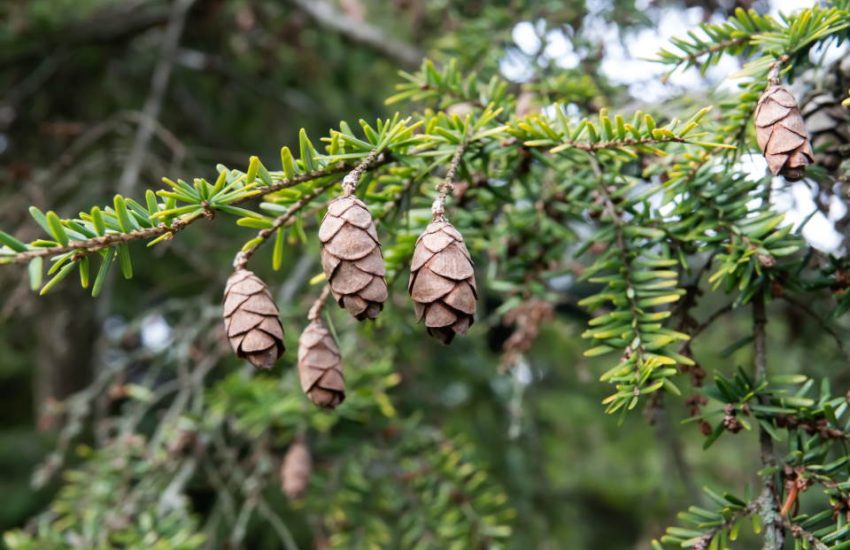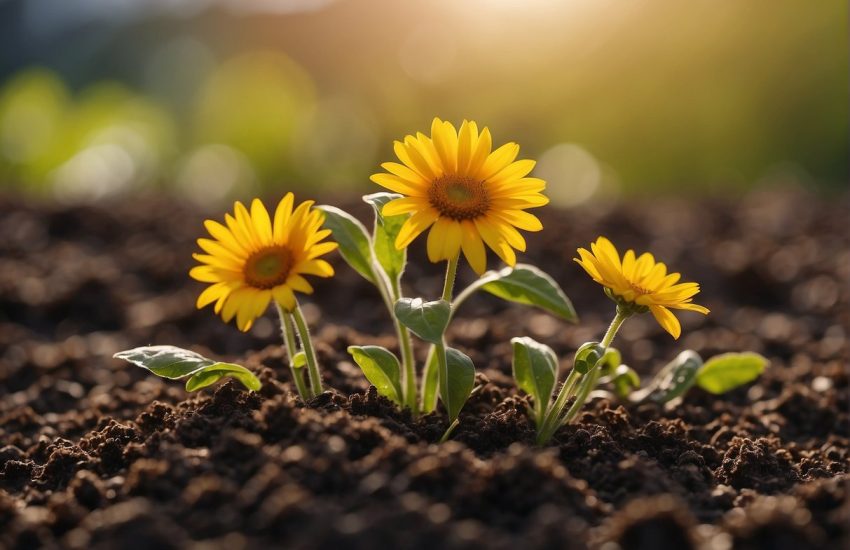Waterwise Gardening for Hot Climates: Essential Strategies for Sustainable Landscaping
Waterwise gardening is all about conserving water while keeping your plants healthy and lively, even when it’s scorching outside. It means picking drought-tolerant plants, watering smartly, and making sure your soil holds onto every drop it can.
This way, you use less water but don’t lose out on a beautiful or productive garden.
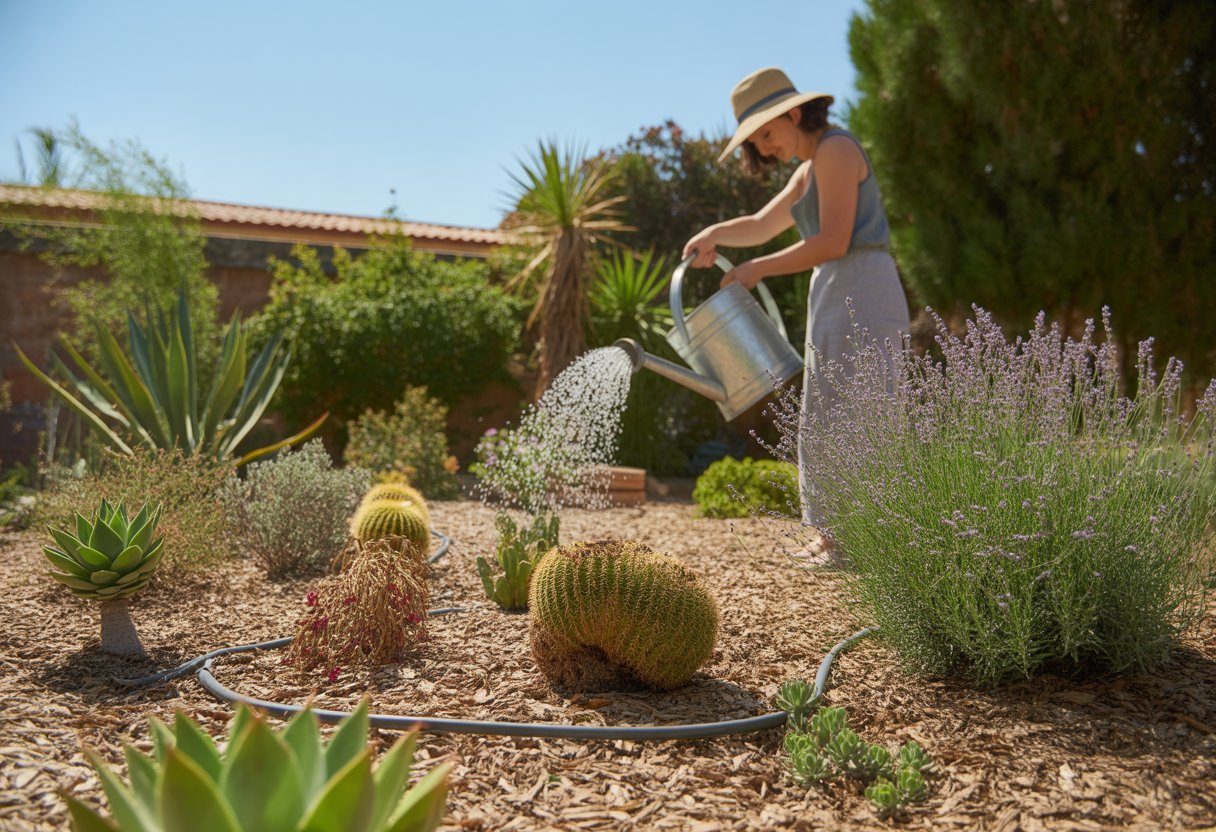
In hot regions, watering the usual way wastes a lot and leaves plants stressed. With some planning and care, you can save water, cut costs, and still end up with a landscape that actually thrives in the heat.
Waterwise gardening methods are practical and really depend on the local environment. If you get a handle on these strategies, you’ll keep your outdoor spaces going strong all year.
Principles of Waterwise Gardening
Waterwise gardening means you’re working with what you’ve got—less water, more heat, and some environmental stress. You need to use techniques that cut down on water use but still keep your plants happy.
Understanding Drought Conditions
Droughts aren’t all the same; sometimes they last forever, sometimes they’re quick, but either way, they make water scarce for gardens. In hot climates, those long dry spells really suck the moisture from the soil and stress out your plants.
If you pay attention to how droughts hit your area, you can pick the right plants and watering methods. Native and drought-tolerant species generally perform better and need less extra watering.
Prepping your soil so it holds water is a must. Keeping an eye on drought levels helps you tweak your watering schedule.
Water restrictions can pop up, too, so it’s smart to focus on tough landscaping choices.
Core Concepts of Water Conservation
Water conservation is about using less and wasting less. Mulching, drip irrigation, and soil amendments are the big three for cutting down evaporation and runoff.
If you use mulch around your plants, you’ll keep the soil cooler and wetter. Drip irrigation sends water right to the roots, so you lose less to the air.
Compost and other soil boosters help the ground hold onto water and keep plants healthier. It makes sense to group plants with similar thirst levels together so you don’t over- or underwater.
Also, watering in the middle of a hot day? Not a great idea—most of it just evaporates.
Impact of Climate Change on Gardening
Climate change is making everything trickier—hotter temps, weird rain patterns, more droughts, and sometimes even surprise floods. Higher temperatures mean water evaporates faster, so you’ve got to get creative.
Choosing plants that can handle surprises and working on your soil’s ability to hold water are key. Deep-rooted plants are a good bet since they can reach moisture way down.
Since weather is getting less predictable, your irrigation routine needs some wiggle room. Collecting rainwater or setting up storage options is becoming more important as things get less predictable.
Selecting Plants for Hot Climates
Picking the right plants for hot climates means going for species that don’t need much water and can take the heat. If you stick with drought-tolerant and native or well-adapted ornamentals, your garden will have a much better shot at surviving—and looking good.
Choosing Drought-Tolerant Plants
Drought-tolerant plants help you save water without turning your garden into a desert. Perennials like sedum, coreopsis, and echinacea do well in dry spots and don’t ask for much once they’re settled in.
Herbs like rosemary, thyme, and agastache are water-savers too, plus they add some nice scents and textures. Succulents such as aloe store water in their leaves, making them perfect for hot, dry places.
If you want color, annuals like zinnias and bougainvillea are tough and don’t need much water. For veggies, tomatoes and melons need a bit more, but if you pick drought-resistant varieties, you’ll still save on water.
The Benefits of Native and Ornamental Plants
Native plants just get your local climate—they need less attention and less water. Things like coneflower, asters, rudbeckia, and gaillardia handle heat well and help out the local ecosystem.
Their deep roots keep soil in place and help it hang onto water. Ornamentals like lavender and artichoke look great and don’t mind the dry heat.
Mixing native and ornamental plants gives you a nice balance of style and practicality.
Designing a Water-Wise Garden
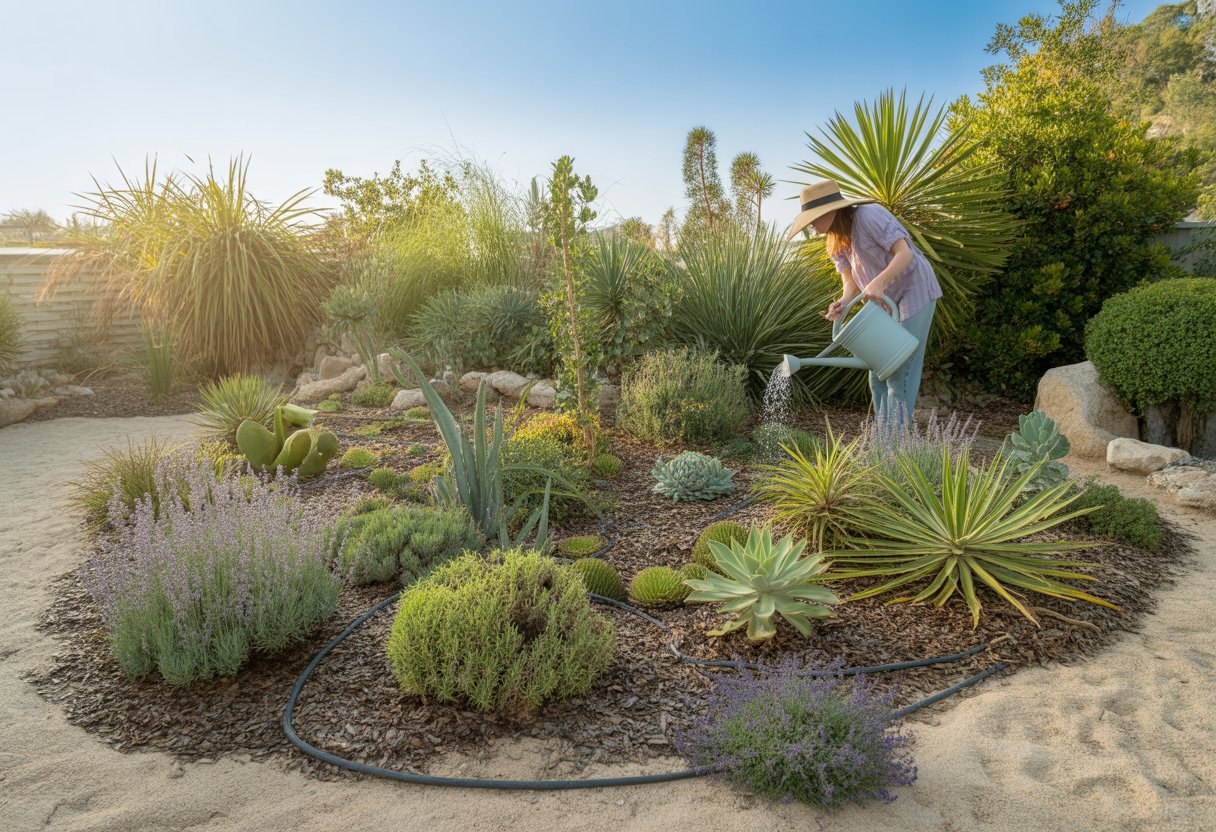
If you want a water-wise garden, you’ve got to think about what you plant, where you put it, and how you use your resources. The goal is to use as little water as possible but still keep things looking good and growing well.
Strategies for Xeriscaping
Xeriscaping is all about using drought-tolerant plants and grouping them by how much water they need. That way, you don’t end up overwatering some and underwatering others.
Start by fixing up your soil with organic matter so it holds water better. Mulch helps keep moisture in and stops the sun from baking your soil.
Stick with local plants—they’re already adapted to your climate. Use drip irrigation to get water right to the roots and avoid wasting it.
Adding rocks or gravel can help cover soil and cut down on water loss.
Efficient Garden Design Techniques
Smart garden design works with the land’s natural flow and microclimates. Plant drought-hardy species on slopes, and use moisture-loving plants in low spots where water collects.
Break your garden into zones based on water needs. Keep thirstier plants near the house or hose for easy watering.
Paths and patios take up space that would otherwise need watering, so they’re a win. Shade trees can keep the ground cooler and help understory plants need less water.
If you plant things to shield the soil, you’ll hold onto more moisture and make life easier for the roots.
Mass Planting for Water Efficiency
Mass planting means putting lots of similar drought-tolerant plants close together. This creates little microclimates that keep the moisture in and the heat out.
When plants are packed together, there’s less bare soil, so you lose less water to evaporation. They shade each other, which helps with heat stress and cuts down on how often you need to water.
If you pick plants with different root depths, they’ll use water more efficiently. Plus, it makes maintenance easier—you can water and care for them all at once.
Best Practices for Water Retention and Soil Health
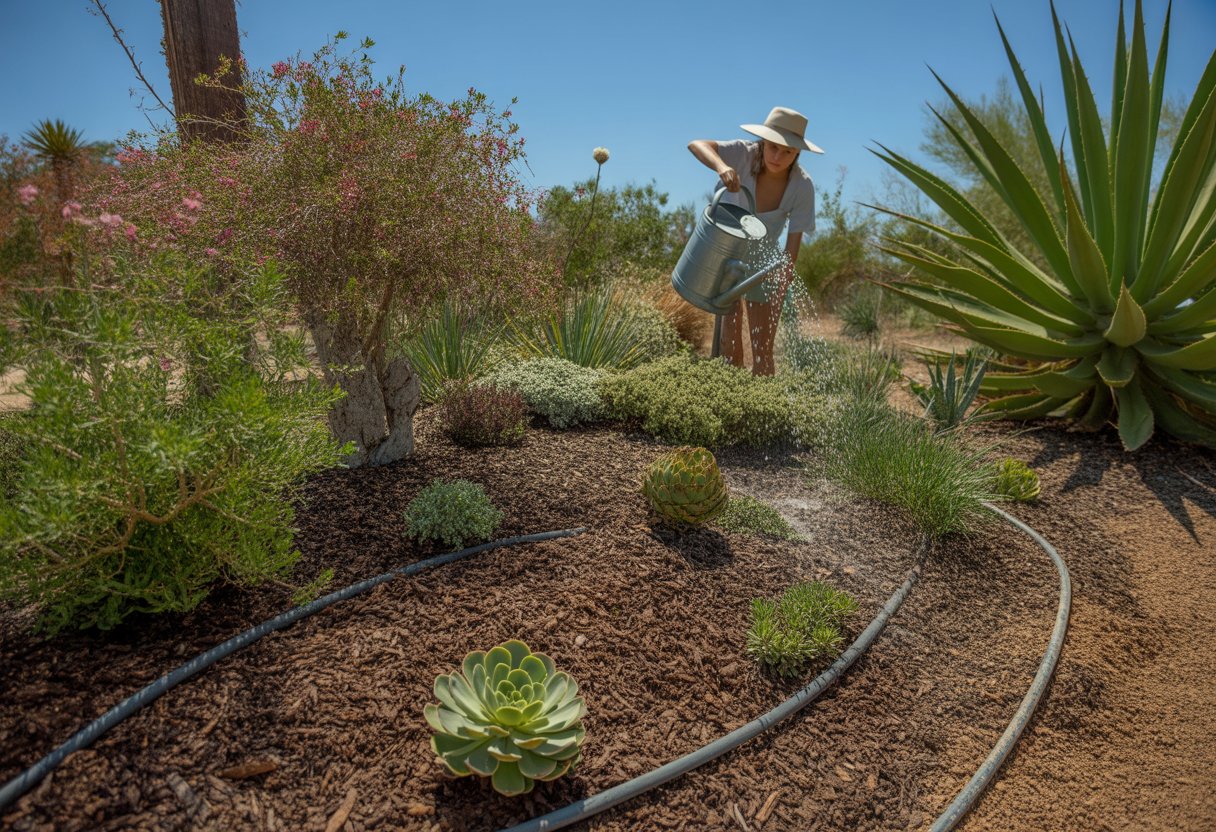
Keeping soil moist in hot climates is all about stopping evaporation and helping the soil hold onto water. Healthy soil with lots of organic material soaks up water better, and sometimes adding water features can help keep things balanced without overdoing it.
Effective Mulching Methods
Mulching is a simple way to keep water in and weeds out. In hot places, bark chips, straw, and gravel are all solid choices.
Each mulch type holds moisture a bit differently. Organic mulches like bark and straw break down over time and feed the soil, which helps it hold even more water.
Aim for a mulch layer about 3 to 5 inches thick. Less than that, and it’s not doing much; more than that, and you could smother your plants or invite pests.
Keep mulch around the roots but away from the stems to avoid rot and keep plants healthy.
Improving Soil with Organic Matter
Adding stuff like aged manure, leaf mold, or cover crops really boosts soil structure. It makes the soil more porous and better at soaking up water.
Soils packed with organic matter drain better and stay moist longer without turning into a swamp. Regularly mixing in organic material encourages good microbes, which help create little soil clumps that trap water and air.
If you’re dealing with sandy soil (and let’s face it, a lot of hot places have it), organic amendments are a game changer for holding onto moisture.
The Role of Composting in Water Retention
Composting turns garden leftovers into nutrient-rich material that makes your soil better at holding water. Compost slowly releases nutrients, so your plants stay healthy without needing tons of extra water.
Spread finished compost on top of the soil or mix it in to bump up moisture retention. Good compost breaks down fast and helps keep soil temperature steady, which is a lifesaver for plants when the heat cranks up.
Water Feature Considerations
Water features like ponds or rain gardens can recycle water and boost humidity in your yard. They also create little microclimates that just feel good to be around.
But here’s the thing: you’ve got to design them carefully. Add some shade and wind barriers to keep evaporation in check.
Rainwater-capturing features help you use less municipal water, which is always a win. If you keep water bodies in good shape, they’ll attract local wildlife and add moisture to the area—without wasting much water.

